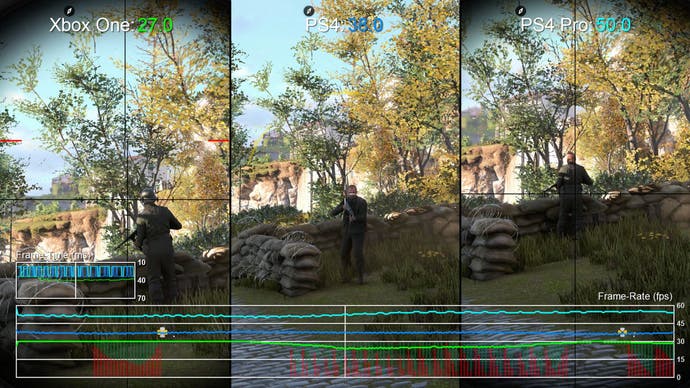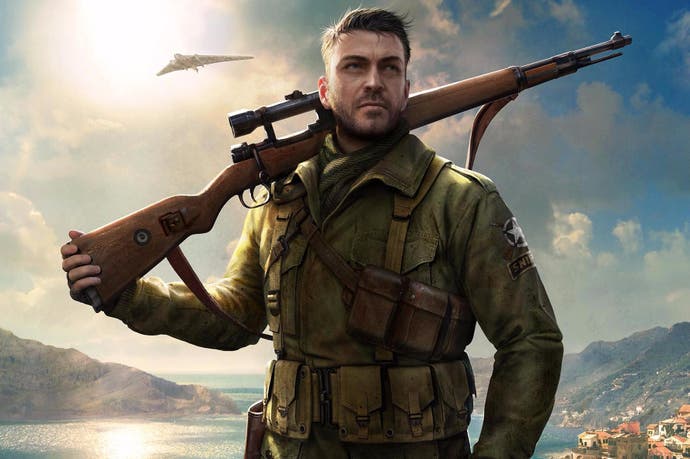Performance Analysis: Sniper Elite 4
Can PS4 Pro's 1080p focus lock us to 60fps? And how do Xbox One and PS4 compare?
Developer Rebellion certainly can't be faulted for its ambition with the new Sniper Elite 4 - the title represents a big step forward for its Asura engine, offering up improved visuals and environments up to three times larger than the last game. On the one hand, this offers up much more freedom in tackling objectives how we like, but on the other, it does demand a lot more from console hardware, with variable results. And just like its predecessor, it's Xbox One that struggles most in delivering consistent performance.
From a visual perspective, Sniper Elite 4 operates at a native 1080p on Xbox One, PlayStation 4 and even PS4 Pro. At first glance, all console versions of the game look very similar, but a closer look sees three distinct levels of visual quality. At the bottom of the pile, Xbox One features less impressive texture and shadow filtering, while object rendering takes a small hit too compared to the base PlayStation 4 release. However, everything else looks fine on Xbox One, matching PS4 down to the grass draw distance, up-close shadow resolution and ambient occlusion quality. There may be a fine margin of difference elsewhere, but the standard PS4 isn't getting too much more as a bonus here - it's more about additional layers of visual refinement, easily missed in the heat of the action.
And the same can be said as we move from PlayStation 4 onto PS4 Pro. In thie case, Rebellion decided not to boost resolution - Sniper Elite 4 resolves native 1080p, even with the Pro set to output a 4K image. The idea here is that the developer uses the machine's extra GPU and CPU horsepower to render out higher quality effects, closer to PC's higher-end settings. According to Rebellion, PS4 Pro enjoys increased draw distances, geometric detail, lighting, shadows and reflections - not to mention improved performance, something we'll address shortly.
As things stand, Pro's visual upgrades are best noticed when put side-by-side with a regular PS4. Otherwise, they tend to be less noticeable. The improved draw distance definitely helps - reducing short-range pop-in and also resolving far more object detail on extended vista views, where far more foliage and even object tessellation is evident. Shadow, lighting and reflection improvements are indeed included, but the boost over the base PS4 isn't exactly revelatory. Sniper Elite 4's visual upgrades are welcome then, but it's really in terms of improved frame-rate where the Pro version shines.
And once again, we're looking at three distinct performance tiers here when it comes to analysing frame-rate - and it's actually this aspect of the game that really separates all three versions in terms of the gameplay experience, far more so than the relatively minor visual differences. On Xbox One you get a capped 30fps set-up, with an adaptive v-sync that allows the game to tear when a frame fails to render within its 33ms render time. In other words, if Xbox One can't hold a stable 30fps - which is very often, sadly - you'll see intrusive full-screen tearing. This means you'll see a perceptible wobble to the screen in taxing areas, with only partial frames pushed out by the Xbox One's less capable GPU. The tearing is a touch frustrating to witness and it has far more of an impact on the look of the game than the console's other minor visual downgrades.
Performance really is an issue for the Microsoft platform. It drops as low as 18fps during scoped-in views, and generally runs in the mid-to-high 20fps region while running around the map. We can't help but wonder whether a drop to 900p may have produced a more consistent performance level - even if resolving far off detail (or targets) may be more challenging.

Meanwhile, v-sync is fully enabled on both PS4 and PS4 Pro, but performance is fully unlocked - and clearly much faster than the Xbox One build. In the case of the base PS4, we can't help but wish that an optional 30fps cap could be included - performance is often very close to the half-refresh experience anyway, and it would have helped to produce a more consistent refresh. Continuous lurching between 30-50fps really does the game few favours, making movement feel quite uneven.
PS4 Pro's enhanced performance is the biggest improvement - to the point where we'd consider trading in the visual upgrades if it could get the frame-rate to more consistently lock to 60fps. But as things stand, the overall experience looks smoother and feels better to play too in terms of improved controller response. However, Pro's performance read-out is still far from a locked 1080p60, with lengthy bouts down to 40-45fps when battles really kick off. But overall, the improved frame-rate here definitely helps and the Pro version is by far the best performing of the trio. That said, we can't help but wonder what a higher resolution Sniper Elite 4 experience would look like, especially if a 30fps cap were introduced.
Just like the last entry in the series, Sniper Elite 4 makes a reasonable case for developers to add an optional 30fps cap, where a title can't hit the optimal 60fps. It's something we actually ended up with on the Xbox One version of Sniper Elite 3, patched in after launch. And with that in mind, perhaps Rebellion will consider adding this feature to the PlayStation releases of Sniper Elite 4 in a future update. However, as things stand, if you're looking for a locked 60fps Sniper Elite 4 experience, the PC release may well be the best option - and we'll be taking a look at that as soon as we can.









